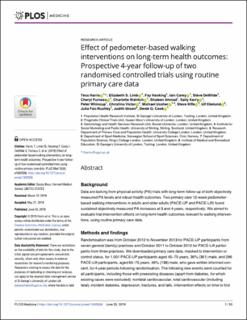| dc.description.abstract | Background: Data are lacking from physical activity (PA) trials with long-term follow-up of both objectively measured PA levels and robust health outcomes. Two primary care 12-week pedometer-based walking interventions in adults and older adults (PACE-UP and PACE-Lift) found sustained objectively measured PA increases at 3 and 4 years, respectively. We aimed to evaluate trial intervention effects on long-term health outcomes relevant to walking interventions, using routine primary care data. Methods and findings: Randomisation was from October 2012 to November 2013 for PACE-UP participants from seven general (family) practices and October 2011 to October 2012 for PACE-Lift participants from three practices. We downloaded primary care data, masked to intervention or control status, for 1,001 PACE-UP participants aged 45–75 years, 36% (361) male, and 296 PACE-Lift participants, aged 60–75 years, 46% (138) male, who gave written informed consent, for 4-year periods following randomisation. The following new events were counted for all participants, including those with preexisting diseases (apart from diabetes, for which existing cases were excluded): nonfatal cardiovascular, total cardiovascular (including fatal), incident diabetes, depression, fractures, and falls. Intervention effects on time to first event post-randomisation were modelled using Cox regression for all outcomes, except for falls, which used negative binomial regression to allow for multiple events, adjusting for age, sex, and study. Absolute risk reductions (ARRs) and numbers needed to treat (NNTs) were estimated. Data were downloaded for 1,297 (98%) of 1,321 trial participants. Event rates were low (<20 per group) for outcomes, apart from fractures and falls. Cox hazard ratios for time to first event post-randomisation for interventions versus controls were nonfatal cardiovascular 0.24 (95% confidence interval [CI] 0.07–0.77, p = 0.02), total cardiovascular 0.34 (95% CI 0.12–0.91, p = 0.03), diabetes 0.75 (95% CI 0.42–1.36, p = 0.34), depression 0.98 (95% CI 0.46–2.07, p = 0.96), and fractures 0.56 (95% CI 0.35–0.90, p = 0.02). Negative binomial incident rate ratio for falls was 1.07 (95% CI 0.78–1.46, p = 0.67). ARR and NNT for cardiovascular events were nonfatal 1.7% (95% CI 0.5%–2.1%), NNT = 59 (95% CI 48–194); total 1.6% (95% CI 0.2%–2.2%), NNT = 61 (95% CI 46–472); and for fractures 3.6% (95% CI 0.8%–5.4%), NNT = 28 (95% CI 19–125). Main limitations were that event rates were low and only events recorded in primary care records were counted; however, any underrecording would not have differed by intervention status and so should not have led to bias. Conclusions: Routine primary care data used to assess long-term trial outcomes demonstrated significantly fewer new cardiovascular events and fractures in intervention participants at 4 years. No statistically significant differences between intervention and control groups were demonstrated for other events. Short-term primary care pedometer-based walking interventions can produce long-term health benefits and should be more widely used to help address the public health inactivity challenge. | en_US |
